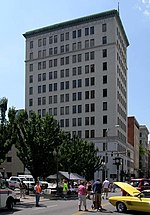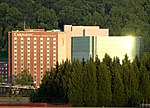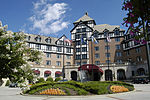Norfolk and Western Railway Company Historic District
Art Deco architecture in VirginiaBuildings and structures in Roanoke, VirginiaCommercial buildings on the National Register of Historic Places in VirginiaHistoric districts on the National Register of Historic Places in VirginiaModerne architecture in Virginia ... and 6 more
NRHP infobox with nocatNational Register of Historic Places in Roanoke, VirginiaNeoclassical architecture in VirginiaNorfolk and Western RailwayRailway stations on the National Register of Historic Places in VirginiaUse mdy dates from August 2023

Norfolk and Western Railway Company Historic District is a national historic district located in Roanoke, Virginia. It encompasses three contributing buildings constructed by the Norfolk and Western Railway (N&W). They are the Neoclassical Revival style General Office Building–South (1896, 1903); the Art Deco period General Office Building–North (1931); and the Moderne style Passenger Station (1905, 1949).
Excerpt from the Wikipedia article Norfolk and Western Railway Company Historic District (License: CC BY-SA 3.0, Authors, Images).Norfolk and Western Railway Company Historic District
Norfolk Avenue Southwest, Roanoke
Geographical coordinates (GPS) Address Nearby Places Show on map
Geographical coordinates (GPS)
| Latitude | Longitude |
|---|---|
| N 37.273055555556 ° | E -79.941944444444 ° |
Address
Norfolk Avenue Southwest
24011 Roanoke
Virginia, United States
Open on Google Maps











